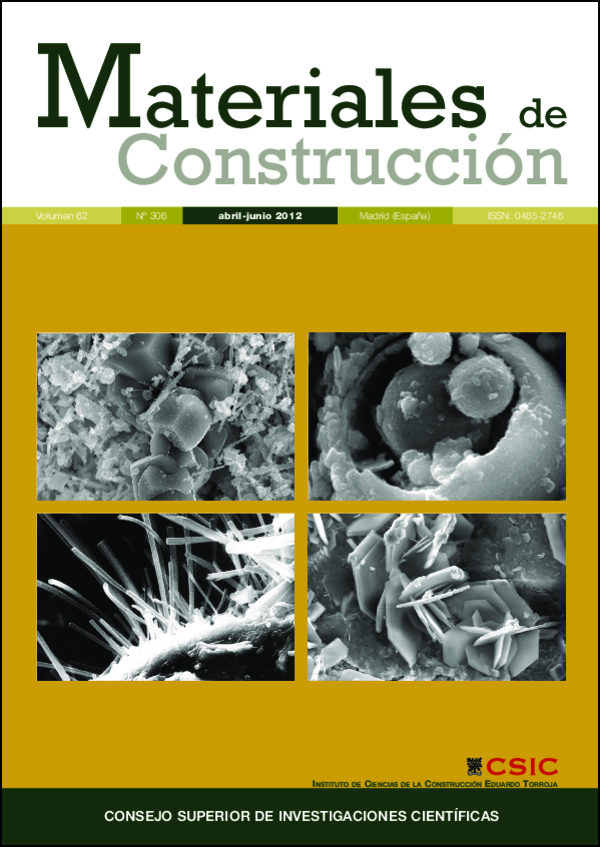Estimating the chloride transport in cement paste
DOI:
https://doi.org/10.3989/mc.2012.02011Keywords:
Diffusion, transport properties, cement paste, chloride, modellingAbstract
A method was developed to measure the diffusion coefficient of chloride ions in cement paste based on an analytical solution to Fick’s 2nd law in a cylindrical coordinate system. This natural method yielded diffusivity results within as little as a month. Testing time was reduced by exploiting the three-dimensional inward flux in the specimen. In an attempt to determine the saturation concentration, dense portland cement pastes were exposed to a concentrated chloride solution. The method proved to be useful for exploring cement hydration-induced changes in the diffusion coefficient of cement paste.
Downloads
References
(1) FIB (CEB-FIP): Model Code for service life design, bulletin 34, http://fib.epfl.ch/publications/fib/
(2) C.L.Page, N.L.Short, A. Tarras, “Diffusion of chloride ions in hardened cement pastes”, Cem Concr Res 11 (3) 195-406 (1981). http://dx.doi.org/10.1016/0008-8846(81)90111-3
(3) O.Francy, R.François, “Measuring chloride diffusion coefficients from non steady state diffusion tests”, Cem Concr Res 28 (7) 947-953 (1998). http://dx.doi.org/10.1016/S0008-8846(98)00070-2
(4) NT BUILD 443, “Concrete, Hardened: Accelerated Chloride Penetration”
(5) D.Whiting, “Rapid determination of the chloride permeability of concrete”, Federal Highway Administration, Report na FHWA/RD-81/119 (1981)
(6) ASTM C 1202-97, “Standard Test Method for Electrical Indication of Concrete’s Ability to Resist Chloride Ion Penetration”
(7) O.Truc, J.P.Ollivier, M.Carcasses, “A new way for determining the chloride diffusion coefficient in concrete from steady statemigration test”, Cem. Conc. Res. 30 (2) 217-226 (2000). http://dx.doi.org/10.1016/S0008-8846(99)00232-X
(8) NT BUILD 492, “Concrete, Mortar and Cement Based Repair Materials: Chloride Migration Coefficient from Non-steady State Migration Experiments”
(9) M.Castellote, C.Andrade, C.Alonso, “Non-steady-state chloride diffusion coefficients obtained from migration and natural diffusion tests: Part II: Different experimental conditions. Joint relations”, Mat. and Struc., 34 323-331 (2001). http://dx.doi.org/10.1007/BF02486483
(10) M.Castellote, C.Andrade, C.Alonso, “Measurement of the steady state and non-steady state chloride diffusion coefficients in a migration teas by means of monitoring the conductivity in the anolyte chamber. Comparison with natural diffusion tests”, Cem Concr Res 31 (10) 1411-1420 (2001). http://dx.doi.org/10.1016/S0008-8846(01)00562-2
(11) R.B.Bird, W.E.Stewart, E.N.Lightfoot, “Fenomeni di trasporto”, Ed.Ambrosiana, Milano, 2004, 572-671
(12) J.Crank, “The Mathematics of Diffusion”, Oxford Science Publications, 1975, 47-73
(13) M.Castellote, C.Andrade, C.Alonso, “Electrochemical removal of chlorides, Modelling of the extraction, resulting profiles and determination of the efficient time of treatment”, Cem Concr Res 30 (4) 615-621(2000). http://dx.doi.org/10.1016/S0008-8846(00)00220-9
(14) H.S.Carslaw, J.C.Jaeger, “Conduction of Heats in Solids”, Oxford Science Publications, 1959, 33-225
(15) A.Princigallo, R.Cucitore, G.Levita, “Chloride Penetration in High Performance Concrete in a Marine Environment: An Experimental Verification”, Cem. and Concrr. Sci. Conf.,Coventry (2004)
(16) http://fasae.ibpmw.uni-essen.de/euproject/inhalt.htm
(17) UNI 9944:1992 Corrosion and protection of reinforcing steel in concrete. Determination of the carbonation depth and of the chlorides penetration profile in concrete.
(18) A.Princigallo, G.Levita, A.Marchetti, G.Gallone, G.L.Guerrini, “Advancements in modelling the development of microstructure in cement pastes”, 7th European Conference on Advanced Materials and Processes, Rimini, (2001)
(19) P.D.Tennis, R.J.Krizek, H.M.Jennings, “Counter-Diffusion as indicator of durability”, Proc. of the 11th Int. Congr. on the Chem. of Cem., Durban (2003)
(20) D.P.Bentz, O.M.Jensen, A.M.Coats, F.P.Glasser, “Influence of silica fume on diffusivity in cement-based materials - I. Experimental and computer modeling studies on cement pastes”, Cem Concr Res, 6 (30) 953-962 (2000). http://dx.doi.org/10.1016/S0008-8846(00)00264-7
(21) P. Halamickova, R.J. Detwiler, D.P. Bentz, and E.J. Garboczi, Water permeability and chloride ion diffusion in portland cement mortars: relationship to sand content and critical pore diameter, Cem Concr Res 4 (25) 790-802 (1995). http://dx.doi.org/10.1016/0008-8846(95)00069-O
(22) O.M.Jensen, P.F.Hansen, A.M.Coats, F.P.Glasser, “Chloride ingress in cement paste and mortar”, Cem Concr Res 29 (9) 1497-1504 (1999). http://dx.doi.org/10.1016/S0008-8846(99)00131-3
(23) W.Dridi, “International RILEM Symposium on Concrete Modelling – CONMOD ’08, RILEM Publications S.A.R.L. 235-237 (2008)
(24) CEN/TS 12390-11:2010 Testing hardened concrete - Part 11: Determination of the chloride resistance of concrete, unidirectional diffusion.
Downloads
Published
How to Cite
Issue
Section
License
Copyright (c) 2012 Consejo Superior de Investigaciones Científicas (CSIC)

This work is licensed under a Creative Commons Attribution 4.0 International License.
© CSIC. Manuscripts published in both the print and online versions of this journal are the property of the Consejo Superior de Investigaciones Científicas, and quoting this source is a requirement for any partial or full reproduction.
All contents of this electronic edition, except where otherwise noted, are distributed under a Creative Commons Attribution 4.0 International (CC BY 4.0) licence. You may read the basic information and the legal text of the licence. The indication of the CC BY 4.0 licence must be expressly stated in this way when necessary.
Self-archiving in repositories, personal webpages or similar, of any version other than the final version of the work produced by the publisher, is not allowed.
















